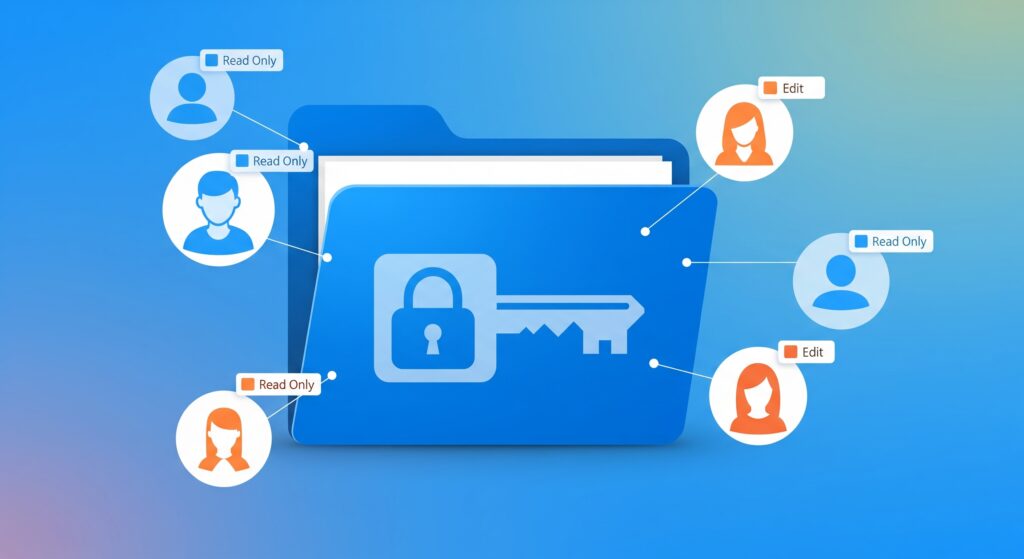No IT department? No problem. Here’s how to keep your files secure and your team productive.
Why SharePoint Permissions Matter (Especially for Small Teams)
When you’re running a small business or nonprofit, the last thing you need is a team member accidentally deleting files, accessing the wrong documents, or getting locked out of what they need.
SharePoint permissions can feel intimidating — but once you understand the basics, it becomes one of the most powerful ways to keep your team organized and protected without constant hand-holding.
The 3 Core SharePoint Roles You Need to Know
Every SharePoint site uses three default permission levels:
Owner – Full control. Can add/remove users, create or delete libraries, and change settings.
Member – Can add, edit, and delete content in areas they have access to.
Visitor – Read-only access. Can view, but not change anything.
💡 For small teams, this is usually all you need. Don’t overcomplicate it unless you have advanced use cases.
The Best Practice for Small Teams: Role-Based Simplicity
Instead of assigning permissions document-by-document or folder-by-folder, use role-based access control (RBAC). That means setting up groups for types of users and assigning permissions once.
Here’s how:
Step-by-Step: How to Set Up Permissions the Right Way
1. Create a Communication or Team Site
Go to SharePoint > “Create site”
Choose a Team Site (collaborative) or Communication Site (info-sharing)
Name it something clear like “HR Hub” or “Operations Central”
2. Identify Your Access Levels
Think in real-life roles — not just departments.
Example:
HR Team: Can edit HR documents
All Staff: Can read templates and policies
Admin Group: Can edit templates and site structure
3. Create SharePoint Groups
In your site:
Go to Site Permissions > Advanced permissions settings
Create groups like:
HR Editors
All Staff (View Only)
Admin Editors
4. Assign Permissions to Document Libraries
For each library (or folder if needed):
Click the 3 dots > Manage Access
Choose Stop Inheriting Permissions (only if you want library-level control)
Grant the appropriate group:
Edit access (for editors)
Read access (for everyone else)
🧠 Pro Tip: Keep permissions at the library level whenever possible. Folder-level customization creates confusion fast.
5. Test Before You Trust
Always test the permissions using a dummy account (or ask a teammate):
Can they see what they should?
Can they edit what they’re allowed to?
Are sensitive files hidden from non-admins?
Example Use Case for a Small Nonprofit
Site: HR Hub
Groups:
HR Managers: Owners
HR Assistants: Members (edit)
All Staff: Visitors (read-only for policy docs)
Board Members: No access at all unless explicitly granted
Document Libraries:
Policies – Read-only for all staff
Recruitment – Editable by HR only
Templates – Editable by Admins, viewable by staff
What Not to Do
❌ Don’t give everyone Owner access — even if you “trust them.” Accidents happen.
❌ Don’t manage permissions file-by-file — it becomes impossible to scale.
❌ Don’t leave default groups untouched — customize them to fit your real team structure.
Want Help Setting It Up?
If this still feels overwhelming or you want to avoid the trial-and-error phase, I’ve created a toolkit that walks you through it all.
Fast Track It
The Fast Track SharePoint Setup Kit includes:
Step-by-step instructions for setting up permissions, libraries, and 10 intranet tools
30+ templates for team onboarding, communication, and planning
A checklist to avoid the most common SharePoint mistakes
Click here to get the Setup Kit — or contact me with any questions you have.
I’d love to support you.
FAQ: SharePoint Permissions for Small Teams
Q: What’s the difference between a Member and an Owner?
A: Owners control site structure and permissions. Members can edit files but can’t change settings.
Q: Can I let someone see one folder only?
A: Yes, but it’s messy. Use library-level permissions for simplicity.
Q: Can I use Microsoft 365 groups instead of SharePoint groups?
A: Yes — for integration with Teams or Outlook groups, M365 groups can help. But for beginners, stick with SharePoint groups for clarity.
🧠 Final Thought
Setting up permissions doesn’t have to be complicated. When you focus on clarity, simplicity, and role-based access, you’ll save your team time and avoid tech headaches down the line.
You’ve got this. And if you need a hand — I’ve got your back.





